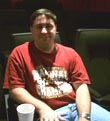|
|
This topic comprises 3 pages: 1 2 3
|
|
Author
|
Topic: Lamphouse Air Temperature
|
|
|
|
|
|
|
John Hawkinson
Film God

Posts: 2273
From: Cambridge, MA, USA
Registered: Feb 2002
|
 posted 05-31-2007 06:26 PM
posted 05-31-2007 06:26 PM




Oddly enough, I was doing that this morning, and got 110F for a 2k in a Xetron XHN2000.
Osram specs the anode base temperature at 230 degrees C (446 degrees F), which is not at all the same thing as the air temperature (see p. 25 of the
XBO Theatre Lamps: Technology and Applications guide.).
On the ozone issue, p.33 would you believe that OFR really is "ozone free":
quote:
An electric discharge in xenon gas generates a spectrum ranging from about 140nm in the UV region to far into the infrared region. If the quartz glass bulb is transparent between at least 180 and 220 nm in the UV region, this radiation converts a small proportion of the atmospheric oxygen (O2) into ozone (O3). Ozone is itself a colorless, odorless gas (what you can smell are the reaction products of ozone as it attacks air-borne pollutants and nitrogen compounds); it is extremely aggressive and will damage your lungs if inhaled at relatively high concentrations over a long period of time.
Ozone emission can be suppressed by using quartz glass which absorbs radiation in the relevant UV region. The result is "ozone-free" lamps, which have the letters "OFR" added to their lamp designation. The quartz glass used is either bulk doped or suitably coated. See the UV radiation output in Fig. 33
Occasionally, even ozone-free lamps give off an "ozone scent" shortly after ignition. This has two possible causes: the ozone is produced either as a result of the (temporary) radiation of the spark gap used for ignition, or from the fact that when the quartz bulb is in the cold state the absorption edge can shift and small amounts of ozone-producing radiation can leave the bulb. Both effects cease once the lamp has started up and are cause of no significance.
Tangentially, I was wondering how involved it is to add a booster supply to an existing rectifier whose no-load voltage is a bit on the low side for striking (an IREM P1-X80 driving a 2K lamp; it just barely makes 80VDC no-load). Is this a straightforward thing to do?
--jhawk
| IP: Logged
|
|
|
|
|
|
Dan Reiter
Film Handler

Posts: 74
From: Easton PA
Registered: Jul 2002
|
 posted 06-01-2007 07:29 AM
posted 06-01-2007 07:29 AM




This thread is covering many areas I have dealt with in the past. From an exhaust standpoint, trying to get an actual temperature has never been exact. For new theater construction, the HVAC guys are always asking about specific air loads, exhaust fan numbers, flows and more. I do not recall this ever being fully quantified. Even the stack diameter and fan CFM can vary. Even the style of internal cooling of the lamphouse can affect exhaust air temperature. There's alot to consider.
As for the older IREMS, only with the recent advent of the higher pressure lamps has the open-circuit voltage become a major issue. The older lamps will still ignite quickly, as will a brand new lamp, but once the lamps get any age, the low open circuit will become a problem. Not the IREM's fault, as they are 20 to 30 years old! As noted in an ealier post, changing the caps and diodes will help, as well as making sure the input 3-phase voltage is at a decent level. The booster is another method. Blame it on progress!
| IP: Logged
|
|
Michael Schaffer
"Where is the
Boardwalk Hotel?"

Posts: 4143
From: Boston, MA
Registered: Apr 2002
|
 posted 06-01-2007 10:12 AM
posted 06-01-2007 10:12 AM





quote: Dan Reiter
This thread is covering many areas I have dealt with in the past. From an exhaust standpoint, trying to get an actual temperature has never been exact. For new theater construction, the HVAC guys are always asking about specific air loads, exhaust fan numbers, flows and more. I do not recall this ever being fully quantified. Even the stack diameter and fan CFM can vary. Even the style of internal cooling of the lamphouse can affect exhaust air temperature. There's alot to consider.
Then there is another aspect which touches us more directly: exactly where to measure the CFMs? "In the exhaust stack" or "at the exhaust stack" can give wildly varying readings, depending on exactly where you hold the probe, in the middle, on the side, exactly at lamphouse roof level, a little inside the stack, a little outside. Generally the idea is simply to measure air speed and then calculate the CFMs based on the area of the exhaust duct cross section. But since there is a lot of turbulence around the exhaust opening, that can be difficult and very imprecise.
| IP: Logged
|
|
|
|
John Hawkinson
Film God

Posts: 2273
From: Cambridge, MA, USA
Registered: Feb 2002
|
 posted 06-01-2007 10:27 AM
posted 06-01-2007 10:27 AM




Yeah, trying to measure the stack CFM with a fan-type probe sure was a pain. I get the feeling maybe it would be better with a hot-wire probe. With the fan-type probe, you're probably changing the static pressure of the system by inserting the probe...
I also tried measuring the CFM at the intake grill of the lamphouse, and got weird results.
Anyhow, I'm no HVAC expert, Steve, but the can't you just do this based on CFM? I mean, whatever CFM your exhaust is pulling out is whatever air it is pulling out. Say it's 1000CFM. Then look at what CFM your booth ventilation return fan is pulling out. Say it's 10,000CFM. Then you can just treat it like your return fan was pulling 11,000 CFM, or de-rate the heat load by 10%. No?
--jhawk
| IP: Logged
|
|
|
|
|
|
|
|
|
|
John Walsh
Film God

Posts: 2490
From: Connecticut, USA, Earth, Milky Way
Registered: Oct 1999
|
 posted 06-04-2007 02:05 PM
posted 06-04-2007 02:05 PM




Totally agree with Dan. More stuff not only makes it more complicated, but some people don't even want to pay for stuff like autostriking, hour and volt meters, and have asked how much we'ed take off to remove those 'fancy extras.' Ack.
Besides, the heat is constant, why vary the exhaust anyway? Dampers or adjustable pullys or speed controls on the roof fan can be used to tweek the rate so the lamp is cooled, but you are not throwing away 'paid for' air conditioned air (if the booth is AC'ed.)
While the impeller type meter may change the CFM rate a little as you measure, I don't think its enough to pay the extra $100 or so for an insert probe. You don't need to know within +- 10 CFM. Besides, the impeller is handy for other areas.
| IP: Logged
|
|
|
|
All times are Central (GMT -6:00)
|
This topic comprises 3 pages: 1 2 3
|
Powered by Infopop Corporation
UBB.classicTM
6.3.1.2
The Film-Tech Forums are designed for various members related to the cinema industry to express their opinions, viewpoints and testimonials on various products, services and events based upon speculation, personal knowledge and factual information through use, therefore all views represented here allow no liability upon the publishers of this web site and the owners of said views assume no liability for any ill will resulting from these postings. The posts made here are for educational as well as entertainment purposes and as such anyone viewing this portion of the website must accept these views as statements of the author of that opinion
and agrees to release the authors from any and all liability.
|

 Home
Home
 Products
Products
 Store
Store
 Forum
Forum
 Warehouse
Warehouse
 Contact Us
Contact Us




 Printer-friendly view of this topic
Printer-friendly view of this topic

















